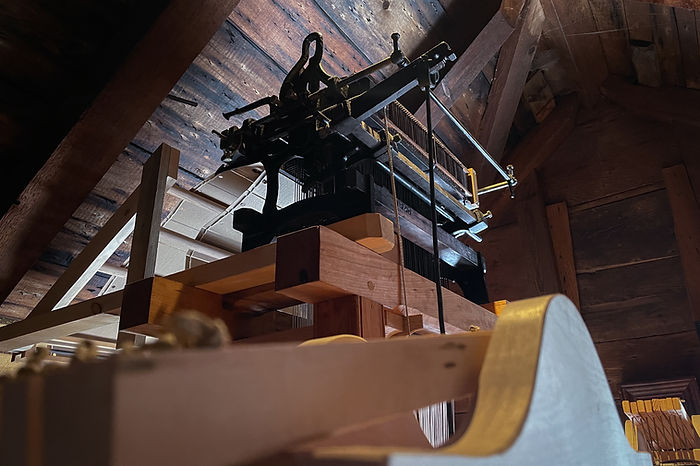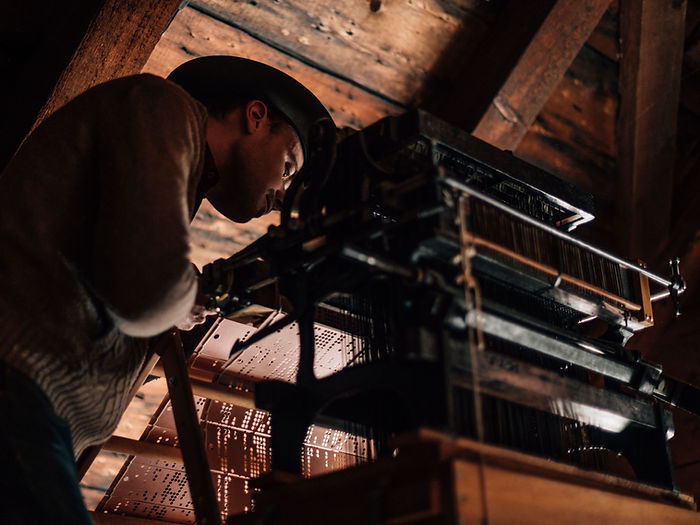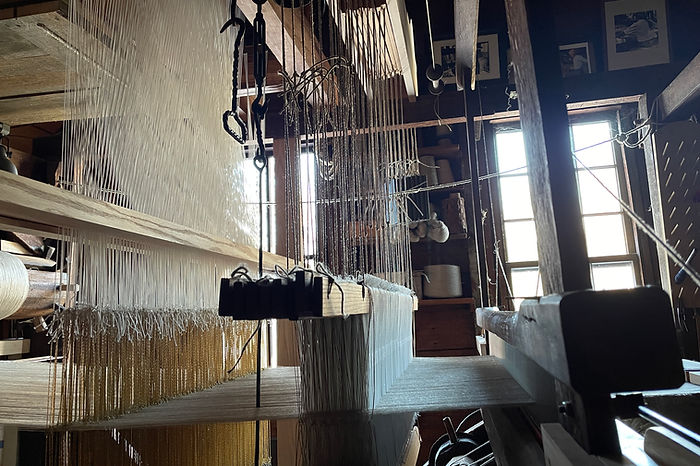
The History of a Jacquard Machine
In 1801 a Lyon silk weaver named Joseph Marie Jacquard perfected a century of technological development with a device that utilized punch cards to create pictorial designs in woven cloth. A series of vertical hooks inside the machine rest over a series of metal bars called knives and are controlled by horizontal wires with a spring on one end and a needle that protrudes from a board on the other. When the punch card is brought against the needle board, any needles that contact solid card are pushed back and the hook they control is moved away from the knife. Any needles that encounter a hole in the card remain in place over the knife. When the knife is raised, all the hooks that were left in place are caught by the knife and carried up with it. Fastened to the lower end of each hook is a harness cord which passes through the comber board, down to the warp below. When a hook is raised so is its cord and mails, and the warp yarns they control. The Jacquard machine allows a single weaver to quickly create figured designs and quickly change patterns due to the interchangeable chains of punch cards. Watch an explanatory video from the Victoria & Albert Museum here.
The single-lift 500 hook Jacquard head that I work with is a rare surviving example dating from the 1850s–60s and is the oldest privately owned operating machine in North America. It was purchased by Roy Orr in the 1990s from Ian Dale of Angus Handloom Weavers in Scotland. Ian is one of the last handloom linen damask weavers in Scotland and the head was a spare that had been kept in the shop for parts. Roy imported the head, harness, and an 1880s piano cutter for card punching to his home in the United States where he mounted it on a modern made handloom. His harness and loom were built for weaving figured coverlets and Roy produced many beautifully crafted pieces. In 2019 Roy decided it was time to pass on his equipment, and thanks to some dedicated friends and a little luck, it came to reside in my farmhouse garret.

After getting acquainted with the Jacquard machine and loom as configured by Roy, I transferred head and harness to an early loom that descended in the Hurd family of Shelton, Connecticut. The unique joinery, use of hewn timber, and decorative features including chamfers with lamb's tongue stops likely date its construction to ca. 1725–1750. While there is no evidence that this loom had ever been used for this type of work in the past, the depth between the warp beam and the breast beam is extremely long, making it ideal for figured weaving. The four post loom frame is exceptionally sturdy, rugged enough to carry the weight of the mechanism. Despite having been built an ocean apart, the two pieces are perfectly suited to one another.

It is very likely that this Jacquard was owned for much of the 20th century by William Taylor, a linen damask weaver in Luthermuir, Kincardineshire, Scotland, who was known in the 1950s and '60s by Norman Kennedy, one of my weaving teachers. Photos from a magazine article about Taylor and video of him at work show him working with a Jacquard with distinctively broken lifting arm, broken in the same shape as the one on mine. Taylor's machines came from his instructor and former employer, a Mr. Winters, who brought six looms from Northern Ireland to begin a damask weaving operation in Scotland in 1920. 600-hook machines with similar castings may be seen on looms at the Irish Linen Centre & Lisburn Museum, Ulster Folk Museum, and Andrew Carnegie Birthplace Museum, and may all have been made by the same manufacturer in the mid-19th century. Out of the thousands in use in the 19th century, I am aware of fewer than twenty of these machines in existence today.

What sets this loom apart from the way many Jacquards are used today is the addition of the front mounting of heddles. As Jacquard machines were made ever larger their hook number increased, giving them the ability to work full harness, with each hook controlling an individual warp yarn. The early lower capacity machines were often used in conjunction with a set of heddles on shafts, the Jacquard lifting groups of warp yarns in the figure harness while the actual weave structure was created by the heddles of a separate pressure harness. My loom operates on this pressure harness system, the Jacquard controlling mails carrying four warp ends that are also individually controlled by an eight-leaf satin pressure harness.

The earliest figured weaving carried out in America was likely accomplished through the use of draw looms, barrel looms, or one of the other devices at use in Europe at the turn of the 19th century. Figured linen damask was already being woven just ten miles away in Ryegate, Vermont before the first Jacquard machine arrived in the United States in 1825. It's a real honor to steward such an important piece of our textile past for future generations.

North Star (Danville, Vermont). Tuesday, May 4, 1824.
